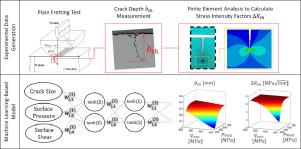International Journal of Mechanical Sciences ( IF 7.1 ) Pub Date : 2021-11-19 , DOI: 10.1016/j.ijmecsci.2021.106949 Maysam B. Gorji 1 , Alix de Pannemaecker 2 , Samuel Spevack 1

|
The present work uses machine learning to predict fretting crack lengths and corresponding stress intensity factors (SIF) under partial slip conditions resulting in crack arrest. Plain fretting tests were first performed on cylinder/flat configurations in partial slip, in which the test sample was flat. Adjusting contact pressure and cylinder radius, both short and long crack arrest responses were achieved for the studied C-Mn steel. Finite element (FE) analysis was then used to compute the fretting SIF threshold ΔKth for each arrested cylinder/plane fretting crack condition. Under elastic fretting conditions, a coupled approach combining complete FE simulations modeling the crack and Rice's fracture integrals was used. When plasticity needed to be considered, an indirect method was applied, using FE simulations without the crack and classical weight functions once elastic shakedown was reached (decoupled approach). The fretting SIF threshold ΔKth could then be extrapolated to estimate the fatigue long crack SIF threshold ΔK0 when the fretting crack was long enough. The novelty of this research work resides in the use of Machine Learning to predict the key mechanical parameters introduced above. A backpropagation algorithm with Bayesian regularization was used to identify a shallow neural network model based on just fourteen experiments. A neural network-based model was then employed to describe fretting crack lengths and corresponding SIF of the studied alloy as a function of the fretting contact radius, the maximum surface pressure, and shear traction. Perfect correlations were obtained to predict both crack depth and associated SIF threshold. An investigation was performed to determine the reliability with which samples sizes matching the count of the available experimental points can be used to predict fretting crack lengths and corresponding SIF. A Monte-Carlo bootstrapping method was used to estimate the output confidence interval corresponding to specific target inputs. This analysis provided optimistic results as relatively small datasets may be sufficient for accurate predictions. The neural network described short to long crack behaviors under elastic or elastoplastic conditions, making it a valuable tool for predicting fatigue long crack ΔK0 based on fretting experiments.
中文翻译:

机器学习预测微动和疲劳的关键机械特性
目前的工作使用机器学习来预测在部分滑动条件下导致裂纹停止的微动裂纹长度和相应的应力强度因子 (SIF)。平面微动测试首先在部分滑动的圆柱/平面配置上进行,其中测试样品是平面的。调整接触压力和圆柱半径,所研究的 C-Mn 钢实现了短裂纹和长裂纹抑制响应。然后使用有限元 (FE) 分析来计算微动 SIF 阈值 Δ K th对于每个制动气缸/平面微动裂纹条件。在弹性微动条件下,结合完整的有限元模拟裂纹和莱斯断裂积分的耦合方法被使用。当需要考虑塑性时,应用了间接方法,一旦达到弹性安定(解耦方法),就使用没有裂纹和经典权重函数的有限元模拟。然后可以外推微动 SIF 阈值 Δ K th来估计疲劳长裂纹 SIF 阈值 Δ K 0当微动裂纹足够长时。这项研究工作的新颖之处在于使用机器学习来预测上面介绍的关键机械参数。使用具有贝叶斯正则化的反向传播算法仅基于 14 个实验来识别浅层神经网络模型。然后采用基于神经网络的模型来描述所研究合金的微动裂纹长度和相应的 SIF 作为微动接触半径、最大表面压力和剪切牵引力的函数。获得了完美的相关性来预测裂纹深度和相关的 SIF 阈值。进行了一项调查,以确定与可用实验点数量匹配的样本大小可用于预测微动裂纹长度和相应 SIF 的可靠性。蒙特卡罗自举方法用于估计对应于特定目标输入的输出置信区间。这种分析提供了乐观的结果,因为相对较小的数据集可能足以进行准确的预测。神经网络描述了弹性或弹塑性条件下的短到长裂纹行为,使其成为预测疲劳长裂纹 Δ 的宝贵工具K 0基于微动实验。











































 京公网安备 11010802027423号
京公网安备 11010802027423号